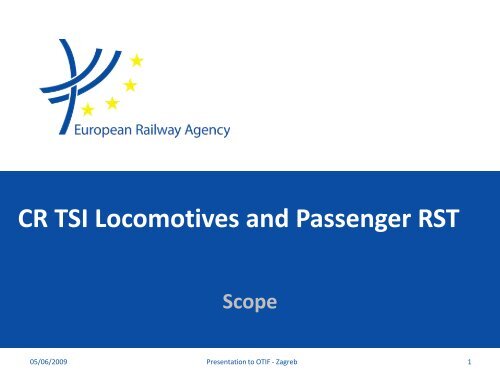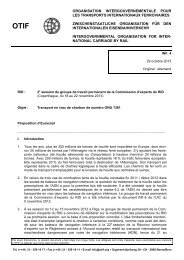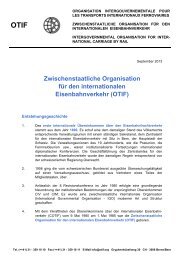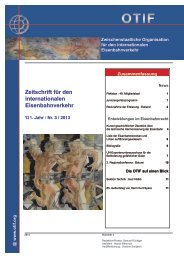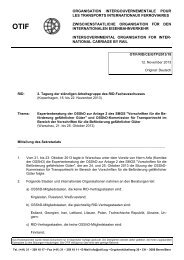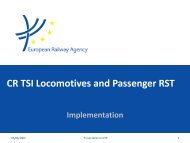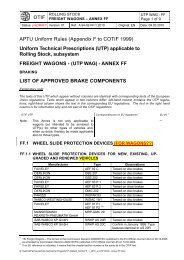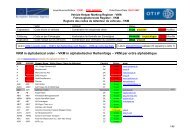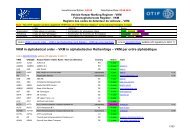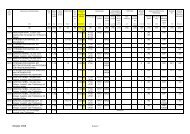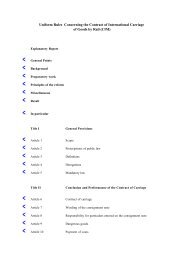CR TSI Locomotives and Passenger RST; Scope - OTIF
CR TSI Locomotives and Passenger RST; Scope - OTIF
CR TSI Locomotives and Passenger RST; Scope - OTIF
Create successful ePaper yourself
Turn your PDF publications into a flip-book with our unique Google optimized e-Paper software.
<strong>CR</strong> <strong>TSI</strong> <strong>Locomotives</strong> <strong>and</strong> <strong>Passenger</strong> <strong>RST</strong><br />
<strong>Scope</strong><br />
05/06/2009 Presentation to <strong>OTIF</strong> - Zagreb 1
• Geographical scope<br />
• Types of <strong>RST</strong> in the scope of <strong>TSI</strong><br />
• Aspects covered by the <strong>TSI</strong><br />
• Aspects not covered<br />
<strong>Scope</strong> of the <strong>CR</strong> LOC&PAS <strong>TSI</strong><br />
• Aspects covered in other <strong>TSI</strong>s (PRM, SRT, Noise)<br />
• Aspect covered by other EU directives<br />
05/06/2009 Presentation to <strong>OTIF</strong> - Zagreb 2
Geographical scope<br />
• The geographical scope of this <strong>TSI</strong> is the <strong>CR</strong> TEN<br />
network.<br />
• The following points of the Directive adopted in 2008 are<br />
not covered (national rules will continue to apply):<br />
• <strong>CR</strong> rolling stock running on the HS network<br />
• Extension to the non-TEN network<br />
• A HS <strong>RST</strong> (speed >= 190 km/h) running on both HS <strong>and</strong><br />
<strong>CR</strong> network will have to comply to both <strong>TSI</strong>s (HS <strong>and</strong> <strong>CR</strong>).<br />
05/06/2009 Presentation to <strong>OTIF</strong> - Zagreb 3
Types of <strong>RST</strong><br />
According to the Directive Annex I, <strong>RST</strong> to be covered by this <strong>TSI</strong> is<br />
classified as follows:<br />
A) Self-propelling thermal <strong>and</strong>/or electric trains<br />
B) Thermal or electric traction units<br />
C) <strong>Passenger</strong> carriages<br />
D) Mobile railway infrastructure construction & maintenance equipment<br />
05/06/2009 Presentation to <strong>OTIF</strong> - Zagreb 4
A) Self-propelling thermal <strong>and</strong>/or electric trains:<br />
Types of <strong>RST</strong><br />
A trainset is a fixed formation that can operate as a train; it is by definition not<br />
intended to be reconfigured, except within a workshop environment. It is<br />
composed of only motored or of motored <strong>and</strong> non-motored vehicles.<br />
An Electric <strong>and</strong>/or Diesel Multiple Unit is a trainset in which all vehicles are<br />
capable of carrying passengers or luggage / mail.<br />
A Railcar is a vehicle that can operate autonomously <strong>and</strong> is capable of carrying<br />
passengers or luggage/mail.<br />
A Light Rail rolling stock is a rolling stock designed to operate mainly on urban<br />
tramway networks; it may operate on limited parts of the conventional rail<br />
system network. It is intended to carry passengers in urban <strong>and</strong> suburban areas<br />
(also known as Tramtrain). it is not in the scope of this <strong>TSI</strong>.<br />
05/06/2009 Presentation to <strong>OTIF</strong> - Zagreb 5
B) Thermal or electric traction units:<br />
Types of <strong>RST</strong><br />
A Locomotive is a traction vehicle (or combination of several vehicles) that is not<br />
intended to carry a payload <strong>and</strong> has the ability to uncouple in normal operation<br />
from a train <strong>and</strong> to operate independently.<br />
It is intended for freight or/<strong>and</strong> passenger transport.<br />
Traction in a self-propelling train can be provided by a powered vehicle with or<br />
without driving cab, which is not intended to be uncoupled during normal<br />
operation. Such a vehicle is called a Power Car in general or a Power Head<br />
when located at one end of the trainset <strong>and</strong> fitted with a driving cab.<br />
A Shunter (shunting locomotive) is a traction unit designed for use only on<br />
shunting yards, stations <strong>and</strong> depots; it is not in the scope of this <strong>TSI</strong>.<br />
05/06/2009 Presentation to <strong>OTIF</strong> - Zagreb 6
C) <strong>Passenger</strong> carriages <strong>and</strong> other related cars:<br />
Types of <strong>RST</strong><br />
<strong>Passenger</strong> carriages: This type includes non-traction vehicles carrying passengers,<br />
<strong>and</strong> operated in a variable formation with vehicles from the category “thermal<br />
or electric traction units” defined above to provide the traction function.<br />
It includes coached <strong>and</strong> fixed Rake of Coaches (non-traction formation of<br />
several coaches “semi-permanently” coupled together, or which can be<br />
reconfigured only when it is out of service).<br />
Non-passenger carrying vehicles included in a passenger train:<br />
Non traction vehicles included in passenger trains (e.g. luggage or postal vans,<br />
car carriers, vehicles for service...) are in the scope of this <strong>TSI</strong>.<br />
Freight wagons are not in the scope of this <strong>TSI</strong>; they are covered by the<br />
“freight wagons” <strong>TSI</strong> even when they are included in a passenger train (the<br />
train composition is in this case an operational issue).<br />
Vehicles intended to carry road motor vehicles with persons on-board these<br />
road motor vehicles are not in the scope of this <strong>TSI</strong>.<br />
05/06/2009 Presentation to <strong>OTIF</strong> - Zagreb 7
Types of <strong>RST</strong><br />
D) Mobile railway infrastructure construction & maintenance equipment (or ontrack<br />
machines)<br />
On track Machines (OTMs) are vehicles specially designed for construction <strong>and</strong><br />
maintenance of the track <strong>and</strong> infrastructure. OTMs are used in different modes:<br />
working mode, transport mode (self-propelling vehicle or hauled vehicle).<br />
Infrastructure inspection vehicles utilised to monitor the condition of the<br />
infrastructure are considered as OTMs as defined above.<br />
This type of rolling stock is in the scope of the <strong>TSI</strong> only when:<br />
It is running on its own rail wheels,<br />
It is designed to have characteristics necessary for the operation of track based<br />
train detection systems <strong>and</strong><br />
it is in transport (running) configuration on its own rail wheels, self-propelled<br />
or hauled.<br />
Working configuration is outside the scope of this <strong>TSI</strong>.<br />
05/06/2009 Presentation to <strong>OTIF</strong> - Zagreb 8
Types of <strong>RST</strong><br />
• For the purpose of the <strong>TSI</strong>, a “Unit” is the entity submitted to<br />
the assessment:<br />
• Locomotive, trainset, carriage, rake of carriages, etc.<br />
• “Units” main categories for the application of the <strong>RST</strong> <strong>TSI</strong>:<br />
• Unit designed to carry passengers or related loads<br />
• Unit fitted with driving cab<br />
• Unit equipped with traction or power equipment<br />
• A “train” is an operational configuration<br />
• Some requirements are expressed at train level<br />
• When the assessed “unit” is not a “train”, interface with<br />
“Operation” to meet the requirement at train level.<br />
• A “vehicle” is the smallest part of a “Unit”<br />
05/06/2009 Presentation to <strong>OTIF</strong> - Zagreb 9
INTEROPERABILITY under<br />
Directive 2008\57\EC<br />
DEFINITION<br />
“the ability of the trans-European<br />
rail system to allow the safe <strong>and</strong><br />
uninterrupted movement of trains“<br />
“this ability depends on all the<br />
regulatory, technical <strong>and</strong><br />
operational conditions which must<br />
be met in order to satisfy the<br />
essential requirements”<br />
05/06/2009 Presentation to <strong>OTIF</strong> - Zagreb<br />
Aspects covered by the <strong>TSI</strong><br />
OBJECTIVES<br />
Facilitate – Improve – Develop<br />
International rail transport service<br />
Achieve interoperability on<br />
The Trans-European Network<br />
Contribute to the creation of an<br />
Internal market in equipment <strong>and</strong><br />
services.<br />
10
Aspects covered by the <strong>TSI</strong><br />
• Requirements to ensure interoperability, as defined in the<br />
Directive, including technical compatibility with other subsystems<br />
(target system as defined by the relevant <strong>TSI</strong>s), <strong>and</strong> safety<br />
related items, expressed as functional requirements.<br />
• These requirements are of m<strong>and</strong>atory application (<strong>TSI</strong> is a law) in<br />
the procedure of EC declaration of verification drawn up by the<br />
Applicant, necessary for Member States to grant the<br />
authorisation for placing in service of vehicles.<br />
• Requirements expressed in the <strong>TSI</strong> correspond to the optimal<br />
level of harmonisation at the level of the EU (Directive, Article<br />
1(2)).<br />
• The examination of the existing regulations (national level) is the<br />
basis for defining technical requirements. The objective is not to<br />
“invent” a new railway system.<br />
05/06/2009 Presentation to <strong>OTIF</strong> - Zagreb 11
Aspects covered by the <strong>TSI</strong><br />
• The specification of technical solutions shall be avoided, except<br />
when strictly necessary (physical interface between subsystems,<br />
widely recognised design proven solution ensuring safety...).<br />
• The economic impact of the requirements shall be analysed, in<br />
order to avoid negative effect on the competitiveness of the<br />
railway sector.<br />
• The <strong>TSI</strong> is not a comprehensive technical specification of a <strong>RST</strong>.<br />
Other technical specifications (customer requirements) are<br />
necessary in order to design a <strong>RST</strong>.<br />
05/06/2009 Presentation to <strong>OTIF</strong> - Zagreb 12
Aspects not covered by the <strong>TSI</strong><br />
• Technical compatibility with existing not <strong>TSI</strong> compliant<br />
subsystems (Infrastructure, Energy, CCS), except when the<br />
existing subsystem is covered by a specific case.<br />
• For locomotives, coaches, vans or trainsets: coupling ability <strong>and</strong><br />
functional interfaces between vehicles, in order to facilitate the<br />
formation of trains with individual vehicles of different origins.<br />
Requirements needed for this functionality include: Coupling <strong>and</strong><br />
buffing gear, Brake interface, Train power supply line, Data<br />
communication bus, Gangway between vehicles.<br />
Decision has been made not to cover this aspect, because it is not<br />
a condition for a vehicle to get an authorisation; it remains in the<br />
voluntary domain (exchange of vehicles between RUs; ref. RIC<br />
agreement).<br />
05/06/2009 Presentation to <strong>OTIF</strong> - Zagreb 13
PRM <strong>TSI</strong><br />
1 st publication<br />
Entered into force 1 July 2008<br />
Applies to both High Speed <strong>and</strong> Conventional Rail systems<br />
Addresses access to people with reduced mobility.<br />
SRT <strong>TSI</strong><br />
1 st publication<br />
Entered into force July 2008<br />
Applies to both High Speed <strong>and</strong> Conventional Rail systems.<br />
Aspects covered in other <strong>TSI</strong>s<br />
Refers to HS <strong>RST</strong> <strong>TSI</strong> for subjects related to fire safety, evacuation <strong>and</strong> rescue.<br />
NOISE <strong>TSI</strong><br />
1 st publication<br />
Entered into force June 2006<br />
Applies to the Conventional Rail system (noise aspects are covered in the HS <strong>RST</strong> <strong>TSI</strong>)<br />
Covers st<strong>and</strong>-by, starting <strong>and</strong> pass-by noise of wagons, locomotives <strong>and</strong> pas. <strong>RST</strong><br />
05/06/2009 Presentation to <strong>OTIF</strong> - Zagreb N° 14
Aspects covered in the PRM <strong>TSI</strong><br />
Commission Decision 2008/164/EC of December 21 st , 2007<br />
Requirements related to <strong>Passenger</strong> amenities in LOC&PAS<br />
<strong>TSI</strong> §4.2.5<br />
Additional requirements in PRM <strong>TSI</strong>:<br />
• Accommodation<br />
seats, including priority seats<br />
wheelchair locations<br />
wheelchair accessible sleeping accommodation<br />
toilets<br />
lighting<br />
• Customer Information.<br />
05/06/2009 Presentation to <strong>OTIF</strong> - Zagreb 15
Aspects covered in the PRM <strong>TSI</strong><br />
Commission Decision 2008/164/EC of December 21 st , 2007<br />
Additional requirements in PRM <strong>TSI</strong> (2):<br />
• Access <strong>and</strong> egress<br />
exterior doors, (incl. dimensions, obstacle detectors<br />
<strong>and</strong> controls)<br />
step <strong>and</strong> boarding aids (position, dimension etc.)<br />
h<strong>and</strong>rails<br />
• <strong>Passenger</strong> circulation<br />
interior doors, (incl. dimensions <strong>and</strong> controls)<br />
floor height changes<br />
clearways (also impacts 4.2.2.3 “gangways”)<br />
05/06/2009 Presentation to <strong>OTIF</strong> - Zagreb 16
Aspects covered in the SRT <strong>TSI</strong><br />
Commission Decision 2008/163/EC of December 20 th , 2007<br />
Categorisation of <strong>RST</strong> for Fire Safety <strong>and</strong> Evacuation defined in<br />
LOC&PAS <strong>TSI</strong><br />
§4.1.4 Follows SRT <strong>TSI</strong> Categories (A, B, Freight <strong>and</strong><br />
OTMs)<br />
§4.2.10.1.1 There is no additional category i.e. Cat A is<br />
the minimum category for <strong>Passenger</strong> <strong>RST</strong><br />
§4.2.10.2 For freight locos <strong>and</strong> OTMs<br />
05/06/2009 Presentation to <strong>OTIF</strong> - Zagreb 17
Cat. B<br />
Categorisation of <strong>RST</strong> in relation to tunnel<br />
length<br />
Designed to operate on all infrastructure of the TEN<br />
15 minutes running capability in order to drive out of<br />
the tunnel in case of fire<br />
Applicable from July 2008 for <strong>CR</strong> <strong>and</strong> HS <strong>RST</strong><br />
Cat. A<br />
Designed to operate in all TEN tunnels of maximum<br />
5km length<br />
4 minutes running capability<br />
Applicable from July 2008 for <strong>CR</strong> <strong>and</strong> HS RS<br />
05/06/2009 Presentation to <strong>OTIF</strong> - Zagreb N° 18
Aspects covered in the SRT <strong>TSI</strong><br />
Commission Decision 2008/163/EC of December 20 th , 2007<br />
Additional requirements to <strong>RST</strong> stated in the SRT <strong>TSI</strong>:<br />
• Fire Detection/protection/mitigation<br />
On board fire detectors<br />
Material properties for rolling stock<br />
Fire extinguishers for passenger rolling stock<br />
Fire barriers for passenger rolling stock (amended by<br />
L&P 4.2.10.5)<br />
Fire protection for freight trains<br />
Respirator in Freight locomotive cab (LOC&PAS<br />
4.2.9.4)<br />
05/06/2009 Presentation to <strong>OTIF</strong> - Zagreb 19
Aspects covered in the SRT <strong>TSI</strong><br />
Commission Decision 2008/163/EC of December 20 th , 2007<br />
Additional requirements to <strong>RST</strong> stated in the SRT <strong>TSI</strong> (2):<br />
• Additional measures for running capability of passenger<br />
rolling stock with a fire on board:<br />
Availability of traction (LOC&PAS 4.2.8.1.2)<br />
Communication means on trains<br />
Emergency brake override<br />
Emergency lighting system in the train<br />
Switching off of air conditioning in the train<br />
• <strong>Passenger</strong> evacuation<br />
Door emergency opening (LOC&PAS 4.2.5.6)<br />
Escape design of passenger rolling stock<br />
Rescue service’s information <strong>and</strong> access<br />
05/06/2009 Presentation to <strong>OTIF</strong> - Zagreb 20
Aspects covered in the NOI <strong>TSI</strong><br />
Commission Decision 2006/66/EC of December 23 rd , 2005<br />
No requirements related to Exterior noise emission in<br />
PAS&LOC <strong>TSI</strong><br />
Requirements for noise emitted by locomotives, multiple units<br />
<strong>and</strong> coaches are stated in the NOI <strong>TSI</strong>:<br />
• Limits for noise emission<br />
limits for stationary noise<br />
limits for starting noise<br />
limits for pass-by noise<br />
• Measuring conditions (EN/ISO 3095 amended by Annex A).<br />
05/06/2009 Presentation to <strong>OTIF</strong> - Zagreb 21
05/06/2009 Presentation to <strong>OTIF</strong> - Zagreb<br />
<strong>TSI</strong>s / Subsystems<br />
Conventional High speed<br />
Rolling stock<br />
LOC&PAS WAG NOI<br />
INF<br />
ENE<br />
TAF<br />
CCS<br />
OPE<br />
SRT<br />
PRM<br />
TAP<br />
<strong>RST</strong> NOI <strong>RST</strong><br />
INF<br />
ENE<br />
Rolling stock<br />
OPE<br />
CCS<br />
22
<strong>TSI</strong>s applicable to <strong>RST</strong><br />
• HS network :<br />
• <strong>RST</strong> <strong>TSI</strong> (including noise), CCS <strong>TSI</strong> (on-board part),<br />
“Access to Persons with Reduced Mobility” <strong>and</strong><br />
“Safety in Railway Tunnels” are in force<br />
• <strong>CR</strong> network:<br />
• Freight Wagons <strong>TSI</strong> is in force<br />
• Noise <strong>TSI</strong>, CCS <strong>TSI</strong> (on-board part), “Access to Persons<br />
with Reduced Mobility” <strong>and</strong> “Safety in Railway<br />
Tunnels” are in force<br />
• <strong>CR</strong> LOC&PAS <strong>TSI</strong> to be published in 2010 (this <strong>TSI</strong>)<br />
05/06/2009 Presentation to <strong>OTIF</strong> - Zagreb 23
Aspects covered by other EU directives<br />
• Electromagnetic compatibility:<br />
Regulation for electromagnetic emission <strong>and</strong> immunity is laid down in Directive<br />
89/336/EEC, <strong>and</strong> st<strong>and</strong>ards EN 50121; regulation for human exposure is laid<br />
down in Directive 2004/40/EC.<br />
They apply for the compatibility of Railway systems with their external<br />
environment (telecommunications...).<br />
• Environmental protection:<br />
Several EU Directives are dealing with this subject. The Interoperability Directive<br />
includes also requirements on environmental protection, referring to the<br />
Community provisions in force.<br />
• Diesel engines exhaust emissions:<br />
Regulation for exhaust emissions is laid down in Directive 97/68/EC.<br />
• Sanitary systems:<br />
Regulation for domestic waste water discharge is laid down in Directive<br />
2000/60/EC.<br />
05/06/2009 Presentation to <strong>OTIF</strong> - Zagreb 24
Denis BIASIN / Hubert LAVOGIEZ<br />
European Railway Agency<br />
Firstname.lastname@era.europa.eu<br />
www.era.europa.eu<br />
Thank you for your attention!<br />
05/06/2009 Presentation to <strong>OTIF</strong> - Zagreb 25


